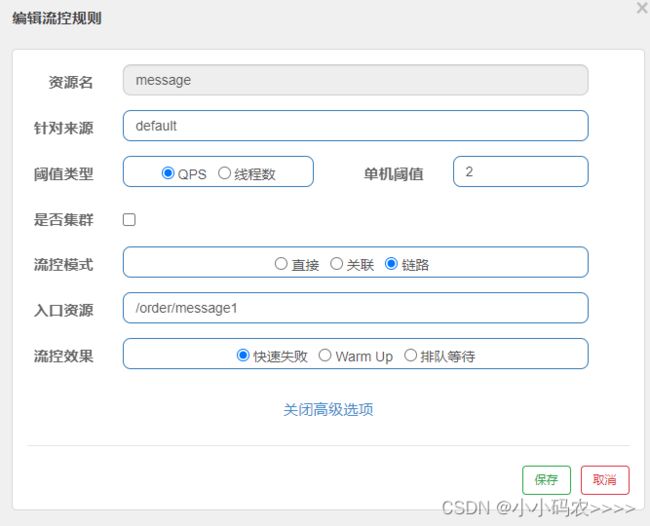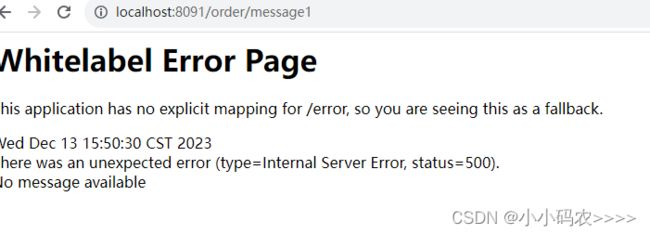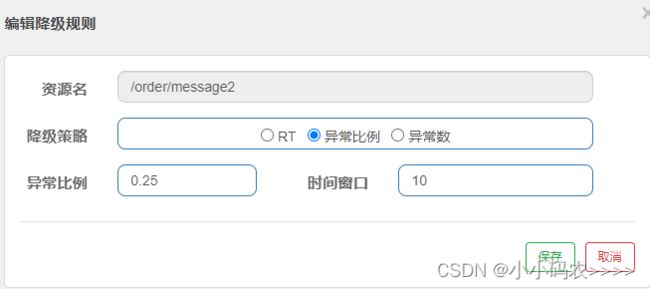第八章 SpringCloud Alibaba 实现Sentinel规则配置和Feign整合
流控规则
流量控制,其原理是监控应用流量的QPS(每秒查询率) 或并发线程数等指标,当达到指定的阈值时
对流量进行控制,以避免被瞬时的流量高峰冲垮,从而保障应用的高可用性。
第1步: 点击簇点链路,我们就可以看到访问过的接口地址,然后点击对应的流控按钮,进入流控规则配
置页面。新增流控规则界面如下:

资源名:唯一名称,默认是请求路径,可自定义
针对来源:指定对哪个微服务进行限流,默认指default,意思是不区分来源,全部限制
阈值类型/单机阈值:
- QPS(每秒请求数量): 当调用该接口的QPS达到阈值的时候,进行限流
- 线程数:当调用该接口的线程数达到阈值的时候,进行限流、
**是否集群:**暂不需要集群
接下来我们以QPS为例来研究限流规则的配置。
简单配置
我们先做一个简单配置,设置阈值类型为QPS,单机阈值为3。即每秒请求量大于3的时候开始限流。
接下来,在流控规则页面就可以看到这个配置。

然后快速访问 /order/message1 接口,观察效果。此时发现,当QPS > 3的时候,服务就不能正常响
应,而是返回Blocked by Sentinel (flow limiting)结果。

配置流控模式
点击上面设置流控规则的编辑按钮,然后在编辑页面点击高级选项,会看到有流控模式一栏。

sentinel共有三种流控模式,分别是:
- 直接(默认):接口达到限流条件时,开启限流
- 关联:当关联的资源达到限流条件时,开启限流 [适合做应用让步]
- 链路:当从某个接口过来的资源达到限流条件时,开启限流
下面呢分别演示三种模式:
直接流控模式
直接流控模式是最简单的模式,当指定的接口达到限流条件时开启限流。上面案例使用的就是直接流控
模式。
关联流控模式
关联流控模式指的是,当指定接口关联的接口达到限流条件时,开启对指定接口开启限流。
第1步:配置限流规则, 将流控模式设置为关联,关联资源设置为的 /order/message2。

第3步:通过JMeter软件向/order/message2连续发送请求,注意QPS一定要大于3


第4步:访问/order/message1,会发现已经被限流

链路流控模式
链路流控模式指的是,当从某个接口过来的资源达到限流条件时,开启限流。它的功能有点类似于针对
来源配置项,区别在于:针对来源是针对上级微服务,而链路流控是针对上级接口,也就是说它的粒度
更细。
第1步: 编写一个service,在里面添加一个方法message
@SentinelResource("message")
@Override
public void message() {
System.out.println("message");
}
第2步: 在Controller中声明两个方法,分别调用service中的方法
@RestController
@Slf4j
public class OrderController3 {
@Autowired
private OrderService orderService;
@RequestMapping("/order/message1")
public String message1() {
orderService.message();
return "message1";
}
@RequestMapping("/order/message2")
public String message2() {
orderService.message();
return "message2";
}
}
第3步: 禁止收敛URL的入口 context
从1.6.3 版本开始,Sentinel Web filter默认收敛所有URL的入口context,因此链路限流不生效。
1.7.0 版本开始(对应SCA的2.1.1.RELEASE),官方在CommonFilter 引入了
WEB_CONTEXT_UNIFY 参数,用于控制是否收敛context。将其配置为 false 即可根据不同的
URL 进行链路限流。
SCA 2.1.1.RELEASE之后的版本,可以通过配置spring.cloud.sentinel.web-context-unify=false即
可关闭收敛
我们当前使用的版本是SpringCloud Alibaba 2.1.0.RELEASE,无法实现链路限流。
目前官方还未发布SCA 2.1.2.RELEASE,所以我们只能使用2.1.1.RELEASE,需要写代码的形式实
现
(1) 暂时将SpringCloud Alibaba的版本调整为2.1.1.RELEASE
<spring-cloud-alibaba.version>2.1.1.RELEASE</spring-cloud-alibaba.version>
(2) 配置文件中关闭sentinel的CommonFilter实例化
server:
port: 8091
tomcat:
max-threads: 5
spring:
application:
name: service-order
datasource:
driver-class-name: com.mysql.jdbc.Driver
url: jdbc:mysql://127.0.0.1:3306/shop?serverTimezone=UTC&useUnicode=true&characterEncoding=utf-8&useSSL=true
username: root
password: root
jpa:
properties:
hibernate:
hbm2ddl:
auto: update
dialect: org.hibernate.dialect.MySQL5InnoDBDialect
cloud:
nacos:
discovery:
server-addr: 127.0.0.1:8848
sentinel:
filter:
enabled: false
transport:
port: 9999 #跟控制台交流的端口,随意指定一个未使用的端口即可
dashboard: localhost:8080 #配置Sentinel dashboard地址
clientIp: localhost
eager: true
(3) 添加一个配置类,自己构建CommonFilter实例
@Configuration
public class FilterContextConfig {
@Bean
public FilterRegistrationBean sentinelFilterRegistration() {
FilterRegistrationBean registration = new FilterRegistrationBean();
registration.setFilter(new CommonFilter());
registration.addUrlPatterns("/*");
// 入口资源关闭聚合
registration.addInitParameter(CommonFilter.WEB_CONTEXT_UNIFY, "false");
registration.setName("sentinelFilter");
registration.setOrder(1);
return registration;
}
}
第4步: 控制台配置限流规则

第5步: 分别通过 /order/message1 和 /order/message2 访问, 发现2没问题, 1的被限流了

配置流控效果
- 快速失败(默认): 直接失败,抛出异常,不做任何额外的处理,是最简单的效果
- **Warm Up:**它从开始阈值到最大QPS阈值会有一个缓冲阶段,一开始的阈值是最大QPS阈值的
1/3,然后慢慢增长,直到最大阈值,适用于将突然增大的流量转换为缓步增长的场景。 - **排队等待:**让请求以均匀的速度通过,单机阈值为每秒通过数量,其余的排队等待; 它还会让设
置一个超时时间,当请求超过超时间时间还未处理,则会被丢弃。
降级规则
- 降级规则就是设置当满足什么条件的时候,对服务进行降级。Sentinel提供了三个衡量条件:
平均响应时间 :当资源的平均响应时间超过阈值(以 ms 为单位)之后,资源进入准降级状态。
如果接下来 1s 内持续进入 5 个请求,它们的 RT都持续超过这个阈值,那么在接下的时间窗口
(以 s 为单位)之内,就会对这个方法进行服务降级。

注意 Sentinel 默认统计的 RT 上限是 4900 ms,超出此阈值的都会算作 4900 ms,若需要
变更此上限可以通过启动配置项 -Dcsp.sentinel.statistic.max.rt=xxx 来配置。
- 异常比例:当资源的每秒异常总数占通过量的比值超过阈值之后,资源进入降级状态,即在接下的
时间窗口(以 s 为单位)之内,对这个方法的调用都会自动地返回。异常比率的阈值范围是 [0.0,
1.0]。
第1步: 首先模拟一个异常
int i =0;
@RequestMapping("/order/message2")
public String message2() {
//异常比例为0.333
if (i % 3 == 0){
throw new RuntimeException();
}
// orderService.message();
return "message2";
}
问题:
流控规则和降级规则返回的异常页面是一样的,我们怎么来区分到底是什么原因导致的呢?
热点规则
热点参数流控规则是一种更细粒度的流控规则, 它允许将规则具体到参数上。
热点规则简单使用
第1步: 编写代码
@RequestMapping("/order/message3")
@SentinelResource("message3")//注意这里必须使用这个注解标识,热点规则不生效
public String message3(String name, Integer age) {
return name + age;
}
第2步: 配置热点规则

第3步: 分别用两个参数访问,会发现只对第一个参数限流了

热点规则增强使用
参数例外项允许对一个参数的具体值进行流控
编辑刚才定义的规则,增加参数例外项

授权规则
很多时候,我们需要根据调用来源来判断该次请求是否允许放行,这时候可以使用 Sentinel 的来源
访问控制的功能。来源访问控制根据资源的请求来源(origin)限制资源是否通过:
其实这个位置要填写的是来源标识,Sentinel提供了 RequestOriginParser 接口来处理来源。
只要Sentinel保护的接口资源被访问,Sentinel就会调用 RequestOriginParser 的实现类去解析
访问来源。
第1步: 自定义来源处理规则
@Component
public class RequestOriginParserDefinition implements RequestOriginParser {
@Override
public String parseOrigin(HttpServletRequest request) {
String serviceName = request.getParameter("serviceName");
return serviceName;
}
}
第2步: 授权规则配置
这个配置的意思是只有serviceName=pc不能访问(黑名单)

第3步: 访问 http://localhost:8091/order/message1?serviceName=pc观察结果

系统规则
系统保护规则是从应用级别的入口流量进行控制,从单台机器的总体 Load、RT、入口 QPS 、CPU
使用率和线程数五个维度监控应用数据,让系统尽可能跑在最大吞吐量的同时保证系统整体的稳定性。
系统保护规则是应用整体维度的,而不是资源维度的,并且仅对入口流量 (进入应用的流量) 生效。
- Load(仅对 Linux/Unix-like 机器生效):当系统 load1 超过阈值,且系统当前的并发线程数超过
系统容量时才会触发系统保护。系统容量由系统的 maxQps * minRt 计算得出。设定参考值一般
是 CPU cores * 2.5。 - RT:当单台机器上所有入口流量的平均 RT 达到阈值即触发系统保护,单位是毫秒。
- 线程数:当单台机器上所有入口流量的并发线程数达到阈值即触发系统保护。
- 入口 QPS:当单台机器上所有入口流量的 QPS 达到阈值即触发系统保护
- CPU使用率:当单台机器上所有入口流量的 CPU使用率达到阈值即触发系统保护。
扩展: 自定义异常返回
//异常处理页面
@Component
public class ExceptionHandlerPage implements UrlBlockHandler {
//BlockException 异常接口,包含Sentinel的五个异常
@SentinelResource
// FlowException 限流异常
// DegradeException 降级异常
// ParamFlowException 参数限流异常
// AuthorityException 授权异常
// SystemBlockException 系统负载异常
@Override
public void blocked(HttpServletRequest request, HttpServletResponse
response, BlockException e) throws IOException {
response.setContentType("application/json;charset=utf-8");
ResponseData data = null;
if (e instanceof FlowException) {
data = new ResponseData(-1, "接口被限流了...");
} else if (e instanceof DegradeException) {
data = new ResponseData(-2, "接口被降级了...");
}
response.getWriter().write(JSON.toJSONString(data));
}
}
@SentinelResource的使用
在定义了资源点之后,我们可以通过Dashboard来设置限流和降级策略来对资源点进行保护。同时还能
通过@SentinelResource来指定出现异常时的处理策略。
@SentinelResource 用于定义资源,并提供可选的异常处理和 fallback 配置项。其主要参数如下:
| 属性 | 作用 |
|---|---|
| value | 资源名称 |
| entryType | entry类型,标记流量的方向,取值IN/OUT,默认是OUT |
| blockHandler | 处理BlockException的函数名称,函数要求:1. 必须是 public2.返回类型 参数与原方法一致3. 默认需和原方法在同一个类中。若希望使用其他类的函数,可配置blockHandlerClass ,并指定blockHandlerClass里面的方法。 |
| blockHandlerClass | 存放blockHandler的类,对应的处理函数必须static修饰。 |
| fallback | 用于在抛出异常的时候提供fallback处理逻辑。fallback函数可以针对所有类型的异常(除了 exceptionsToIgnore 里面排除掉的异常类型)进行处理。函数要求:1. 返回类型与原方法一致2. 参数类型需要和原方法相匹配3. 默认需和原方法在同一个类中。若希望使用其他类的函数,可配置fallbackClass ,并指定fallbackClass里面的方法。 |
| fallbackClass | 存放fallback的类。对应的处理函数必须static修饰。 |
| defaultFallback | 用于通用的 fallback 逻辑。默认fallback函数可以针对所有类型的异常进行处理。若同时配置了 fallback 和 defaultFallback,以fallback为准。函数要求:1. 返回类型与原方法一致2. 方法参数列表为空,或者有一个 Throwable 类型的参数。3. 默认需要和原方法在同一个类中。若希望使用其他类的函数,可配置fallbackClass ,并指定 fallbackClass 里面的方法。 |
| exceptionsToIgnore | 指定排除掉哪些异常。排除的异常不会计入异常统计,也不会进入fallback逻辑,而是原样抛出。 |
| exceptionsToTrace | 需要trace的异常 |
定义限流和降级后的处理方法
方式一:直接将限流和降级方法定义在方法中
int i = 0;
@SentinelResource(
value = "message",
blockHandler = "blockHandler",//指定发生BlockException时进入的方法
fallback = "fallback"//指定发生Throwable时进入的方法
)
public String message1() {
i++;
if (i % 3 == 0) {
throw new RuntimeException();
}
return "message";
}
//BlockException时进入的方法
public String blockHandler(BlockException ex) {
log.error("{}", ex);
return "接口被限流或者降级了...";
}
//Throwable时进入的方法
public String fallback(Throwable throwable) {
log.error("{}", throwable);
return "接口发生异常了...";
}
方式二: 将限流和降级方法外置到单独的类中
@SentinelResource(
value = "message",
blockHandlerClass = OrderServiceImpl3BlockHandlerClass.class,
blockHandler = "blockHandler",
fallbackClass = OrderServiceImpl3FallbackClass.class,
fallback = "fallback"
)
public String message2() {
i++;
if (i % 3 == 0) {
throw new RuntimeException();
}
return "message4";
}
@Slf4j
public class OrderServiceImpl3FallbackClass {
//注意这里必须使用static修饰方法
public static String fallback(Throwable throwable) {
log.error("{}", throwable);
return "接口发生异常了...";
}
}
@Slf4j
public class OrderServiceImpl3BlockHandlerClass {
//注意这里必须使用static修饰方法
public static String blockHandler(BlockException ex) {
log.error("{}", ex);
return "接口被限流或者降级了...";
}
}
Sentinel规则持久化
通过前面的讲解,我们已经知道,可以通过Dashboard来为每个Sentinel客户端设置各种各样的规
则,但是这里有一个问题,就是这些规则默认是存放在内存中,极不稳定,所以需要将其持久化。
本地文件数据源会定时轮询文件的变更,读取规则。这样我们既可以在应用本地直接修改文件来更
新规则,也可以通过 Sentinel 控制台推送规则。以本地文件数据源为例,推送过程如下图所示:

首先 Sentinel 控制台通过 API 将规则推送至客户端并更新到内存中,接着注册的写数据源会将新的
规则保存到本地的文件中。
1 编写处理类
public class FilePersistence implements InitFunc {
@Value("spring.application:name")
private String appcationName;
@Override
public void init() throws Exception {
String ruleDir = System.getProperty("user.home") + "/sentinelrules/" + appcationName;
String flowRulePath = ruleDir + "/flow-rule.json";
String degradeRulePath = ruleDir + "/degrade-rule.json";
String systemRulePath = ruleDir + "/system-rule.json";
String authorityRulePath = ruleDir + "/authority-rule.json";
String paramFlowRulePath = ruleDir + "/param-flow-rule.json";
this.mkdirIfNotExits(ruleDir);
this.createFileIfNotExits(flowRulePath);
this.createFileIfNotExits(degradeRulePath);
this.createFileIfNotExits(systemRulePath);
this.createFileIfNotExits(authorityRulePath);
this.createFileIfNotExits(paramFlowRulePath);
// 流控规则
ReadableDataSource<String, List<FlowRule>> flowRuleRDS = new
FileRefreshableDataSource<>(
flowRulePath,
flowRuleListParser
);
FlowRuleManager.register2Property(flowRuleRDS.getProperty());
WritableDataSource<List<FlowRule>> flowRuleWDS = new
FileWritableDataSource<>(
flowRulePath,
this::encodeJson
);
WritableDataSourceRegistry.registerFlowDataSource(flowRuleWDS);
// 降级规则
ReadableDataSource<String, List<DegradeRule>> degradeRuleRDS = new
FileRefreshableDataSource<>(
degradeRulePath,
degradeRuleListParser
);
DegradeRuleManager.register2Property(degradeRuleRDS.getProperty());
WritableDataSource<List<DegradeRule>> degradeRuleWDS = new
FileWritableDataSource<>(
degradeRulePath,
this::encodeJson
);
WritableDataSourceRegistry.registerDegradeDataSource(degradeRuleWDS);
// 系统规则
ReadableDataSource<String, List<SystemRule>> systemRuleRDS = new
FileRefreshableDataSource<>(
systemRulePath,
systemRuleListParser
);
SystemRuleManager.register2Property(systemRuleRDS.getProperty());
WritableDataSource<List<SystemRule>> systemRuleWDS = new
FileWritableDataSource<>(
systemRulePath,
this::encodeJson
);
WritableDataSourceRegistry.registerSystemDataSource(systemRuleWDS);
// 授权规则
ReadableDataSource<String, List<AuthorityRule>> authorityRuleRDS = new
FileRefreshableDataSource<>(
authorityRulePath,
authorityRuleListParser
);
AuthorityRuleManager.register2Property(authorityRuleRDS.getProperty());
WritableDataSource<List<AuthorityRule>> authorityRuleWDS = new
FileWritableDataSource<>(
authorityRulePath,
this::encodeJson
);
WritableDataSourceRegistry.registerAuthorityDataSource(authorityRuleWDS);
// 热点参数规则
ReadableDataSource<String, List<ParamFlowRule>> paramFlowRuleRDS = new
FileRefreshableDataSource<>(
paramFlowRulePath,
paramFlowRuleListParser
);
ParamFlowRuleManager.register2Property(paramFlowRuleRDS.getProperty());
WritableDataSource<List<ParamFlowRule>> paramFlowRuleWDS = new
FileWritableDataSource<>(
paramFlowRulePath,
this::encodeJson
);
ModifyParamFlowRulesCommandHandler.setWritableDataSource(paramFlowRuleWDS);
}
private Converter<String, List<FlowRule>> flowRuleListParser = source ->
JSON.parseObject(
source,
new TypeReference<List<FlowRule>>() {
}
);
private Converter<String, List<DegradeRule>> degradeRuleListParser = source
-> JSON.parseObject(
source,
new TypeReference<List<DegradeRule>>() {
}
);
private Converter<String, List<SystemRule>> systemRuleListParser = source ->
JSON.parseObject(
source,
new TypeReference<List<SystemRule>>() {
}
);
private Converter<String, List<AuthorityRule>> authorityRuleListParser =
source -> JSON.parseObject(
source,
new TypeReference<List<AuthorityRule>>() {
}
);
private Converter<String, List<ParamFlowRule>> paramFlowRuleListParser =
source -> JSON.parseObject(
source,
new TypeReference<List<ParamFlowRule>>() {
}
);
private void mkdirIfNotExits(String filePath) throws IOException {
File file = new File(filePath);
if (!file.exists()) {
file.mkdirs();
}
}
private void createFileIfNotExits(String filePath) throws IOException {
File file = new File(filePath);
if (!file.exists()) {
file.createNewFile();
}
}
private <T> String encodeJson(T t) {
return JSON.toJSONString(t);
}
}
2 添加配置
在resources下创建配置目录 META-INF/services ,然后添加文件
com.alibaba.csp.sentinel.init.InitFunc

在文件中添加配置类的全路径
com.itheima.config.FilePersistence
Feign整合Sentinel
第1步: 引入sentinel的依赖
<dependency>
<groupId>com.alibaba.cloud</groupId>
<artifactId>spring-cloud-starter-alibaba-sentinel</artifactId>
<version>2.1.1.RELEASE</version>
</dependency>
第2步: 在配置文件中开启Feign对Sentinel的支持
server:
port: 8091
tomcat:
max-threads: 5
spring:
application:
name: service-order
datasource:
driver-class-name: com.mysql.jdbc.Driver
url: jdbc:mysql://127.0.0.1:3306/shop?serverTimezone=UTC&useUnicode=true&characterEncoding=utf-8&useSSL=true
username: root
password: root
jpa:
properties:
hibernate:
hbm2ddl:
auto: update
dialect: org.hibernate.dialect.MySQL5InnoDBDialect
cloud:
nacos:
discovery:
server-addr: 127.0.0.1:8848
sentinel:
filter:
enabled: false
transport:
port: 9999 #跟控制台交流的端口,随意指定一个未使用的端口即可
dashboard: localhost:8080 #配置Sentinel dashboard地址
clientIp: localhost
eager: true
feign: #支持feign
sentinel:
enabled: true
第3步: 创建容错类
//容错类要求必须实现被容错的接口,并为每个方法实现容错方案
@Component
@Slf4j
public class ProductServiceFallBack implements ProductService {
@Override
public Product findByPid(Integer pid) {
Product product = new Product();
product.setPid(-1);
return product;
}
}
第4步: 为被容器的接口指定容错类
//value用于指定调用nacos下哪个微服务
//fallback用于指定容错类
@FeignClient(value = "service-product",
fallback = ProductServiceFallBack.class)
public interface ProductService {
@GetMapping(value = "/product/{pid}")
Product findByPid(@PathVariable("pid") Integer pid);
}
第5步: 修改controller
@RequestMapping("/order/prod/{pid}")
public Order order1(@PathVariable("pid") Integer pid) {
log.info("接收到{}号商品的下单请求,接下来调用商品微服务查询此商品信息", pid);
//调用商品微服务,查询商品信息
Product product = productService.findByPid(pid);
if (product.getPid() == -1) {
Order order = new Order();
order.setPname("下单失败");
return order;
}
log.info("查询到{}号商品的信息,内容是:{}", pid, JSON.toJSONString(product));
//下单(创建订单)
Order order = new Order();
order.setUid(1);
order.setUsername("测试用户");
order.setPid(pid);
order.setPname(product.getPname());
order.setPprice(product.getPprice());
order.setNumber(1);
orderService.save(order);
log.info("创建订单成功,订单信息为{}", JSON.toJSONString(order));
try {
Thread.sleep(100);
} catch (InterruptedException e) {
e.printStackTrace();
}
return order;
}
}
第6步: 停止所有 shop-product 服务,重启 shop-order 服务,访问请求,观察容错效果

扩展: 如果想在容错类中拿到具体的错误,可以使用下面的方式
@FeignClient(
value = "service-product",
//fallback = ProductServiceFallBack.class,
fallbackFactory = ProductServiceFallBackFactory.class)
public interface ProductService {
@GetMapping(value = "/product/{pid}")
Product findByPid(@PathVariable("pid") Integer pid);
}
@Component
public class ProductServiceFallBackFactory implements FallbackFactory<ProductService> {
@Override
public ProductService create(Throwable throwable) {
return new ProductService() {
@Override
public Product findByPid(Integer pid) {
throwable.printStackTrace();
Product product = new Product();
product.setPid(-1);
return product;
}
};
}
}
注意: fallback和fallbackFactory只能使用其中一种方式
- 第九章 SpringCloud Alibaba 实现 Gateway–服务网关


